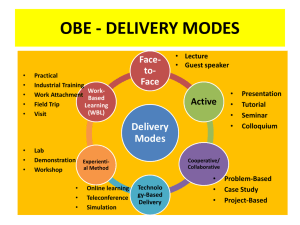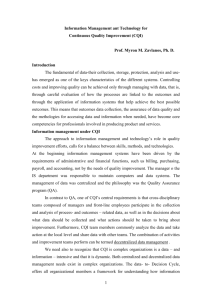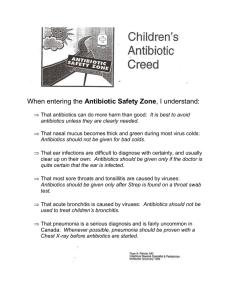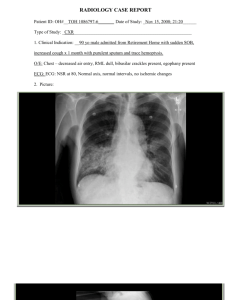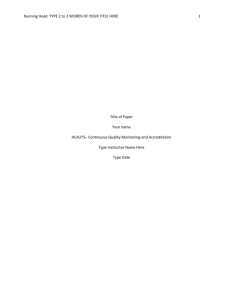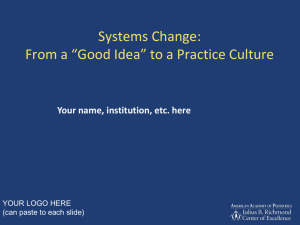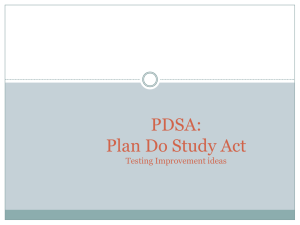Rapid Improvement Strategies
advertisement
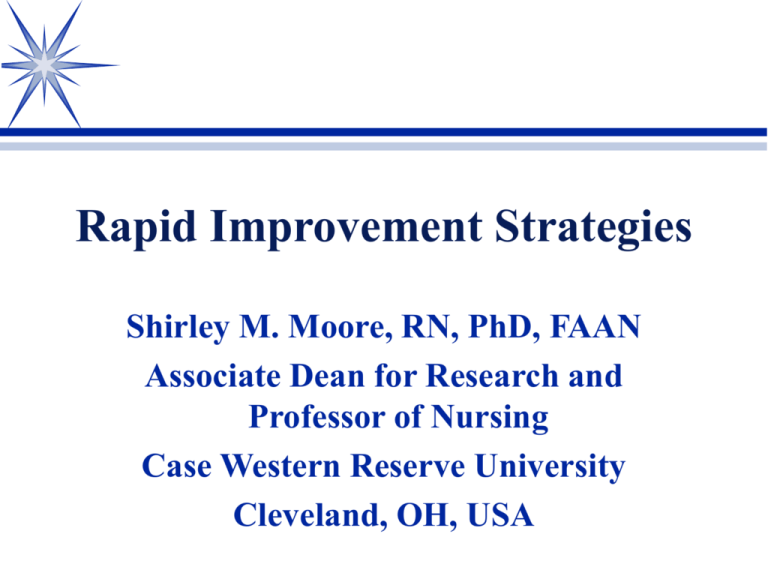
Rapid Improvement Strategies Shirley M. Moore, RN, PhD, FAAN Associate Dean for Research and Professor of Nursing Case Western Reserve University Cleveland, OH, USA Rapid Improvement Strategies One of the criticisms of CQI is that it can take a long time to plan, test, and evaluate an improvement Making fast changes lasting and pervasive, rapid improvement strategies speed things up without changing the nature of necessary improvement activities Objectives Describe the key focuses of rapid improvement strategies Compare traditional and rapid improvement strategies Apply rapid improvement strategies to an improvement initiative Making rapid improvement work.... Interdisciplinary Systems approach Throw away your hats Take risks Take ownership As in the use of traditional improvement strategies, to help develop tests and implement changes using rapid improvement strategies, the PDSA cycle is used as a framework for an efficient trial-and-learning methodology When using rapid improvement strategies, the goal is to speed up cycles, thus making change faster Plan-Do-Study-Act (PDSA) Plan--a change, preferably on a small scale Do--carry out the plan Study--the effects of the change, making simple measurements Act--on what you learn to plan the next round of testing “Trial and Learning” Small scale tests Simple measurements Five steps to speed up change Wasting time working on the wrong problem 1. Define the right problem Ineffective Meetings 2. Rapid meetings Planning and not acting 3. Rapid plans Too much time collecting data Selling change to others 4. Rapid data collection 5. Rapid whole system change Define the Right Problem Postpone benchmarking when problems are obvious Waiting for data to clarify problems can delay improvement efforts Using data you “have” may lead to an inaccurate improvement Focus benchmarking on a “few problems” Define the Right Problem Creates a focus on the “system” and not the staff Problem statement: “The inability of the ED to initiate antibiotics in a timely manner.” Problem restated: “Delay in antibiotic administration for pneumonia patients.” Define the Right Problem Define the problem in terms of the customers experience, obtain information via: focus groups interviews observations questionnaires Define the Right Problem State the problem from different perspectives Problem statements often include the environment for improvement Increases focus on the team’s scope Problem statement: “Sixty percent of pneumonia patients get antibiotics in the ED.” Problem statement: “Forty percent of pneumonia patients do not get antibiotics in the ED.” Define the Right Problem State the problem from different perspectives Team exercise: • • Have all team members define the problem Compare answers to identify the various ways to approach the problem. Rapid Meetings Choose a nonparticipating facilitator • • keep group on track and focused identify team problems Meet before the meetings • • present team focus and agenda to members for feedback (electronic, telephone, etc) initiates ideas prior to meetings, increases interaction and problem-solving Rapid Meetings Postpone evaluation of ideas • • increases amount and creativity of ideas. minimizes “group think” Think it through again • • improves teams original decisions considers all perspectives Rapid Meetings Meet between meetings • • • Electronic feedback on issues (e-mail)-eliminates evaluation of ideas and minimizes group think Allows for “drafts” to be revised, updated and represented More meeting time available for approval of action plans, decision making, and finalizing implementation strategies Plan Rapidly Start with what “could be” and not “what is”....Ideal system design...Futuring • • • • Fits solution to system Generates solutions before understanding constraints, increasing creativity Brainstorm ideal solution, then define realistic improvement approach Minimizes time spent flowcharting the current process Plan Rapidly Know Your Cast Champions Agents Sponsors Targets Collect data rapidly Write outcomes reports before begin data collection, including tables and figure Collect only data you need Representative surveys of customers Increase speed of data collection by using numerical and subjective data Collect data rapidly Rely on numerical estimates made by process owners • • • • Derive from subjective data based on observations and feedback Involve a cross-section of experts involved in the process Analyze and display outcomes Experts discuss and re-estimate outcomes Rapid Whole-System Changes Cross-functional teams--interdisciplinary Internal and external experts Unfolding storyboards • • • employees follow team progress understand evolution of change increase involvement and feedback Rapid Whole-System Changes Employees need to feel they are capable of change Employees are more likely to change when they participated in the decision making process and have organizational support Top down approach Maintain focus with reminders and updates Focus on early adopters Strength of Evidence Beyond reasonable doubt Preponderance of evidence Common Sense Summary Application of a set of strategies can be employed to speed up the CQI process Rapid improvement strategies do not bypass the basic steps of the CQI process they speed up the planning, measurement and PDSA cycle time Using rapid improvement strategies often means getting rid of old, ritualistic organizational change behaviors References Alemi, F., Moore, S. M., Headrick, L., Heckelman, F., Kizys, N., & Neuhauser, D. (1998). Rapid improvement. The Joint Commission Journal on Quality Improvement, 24, 119-129.

